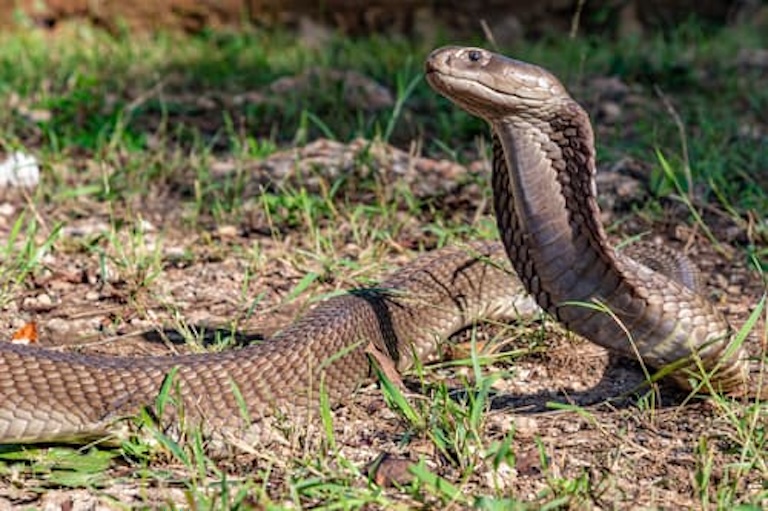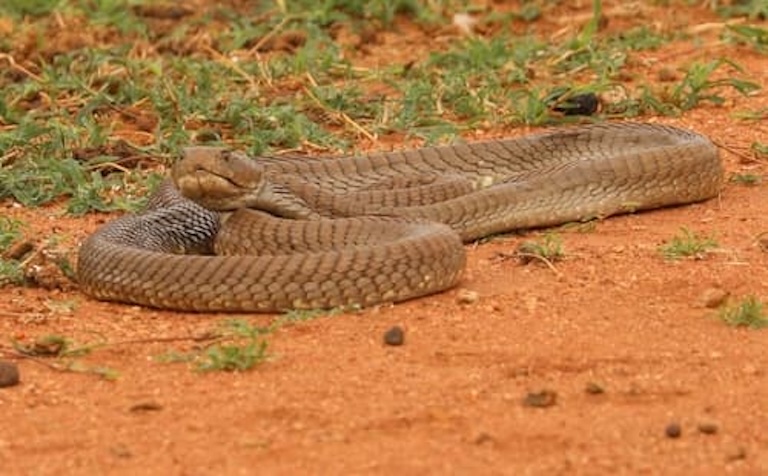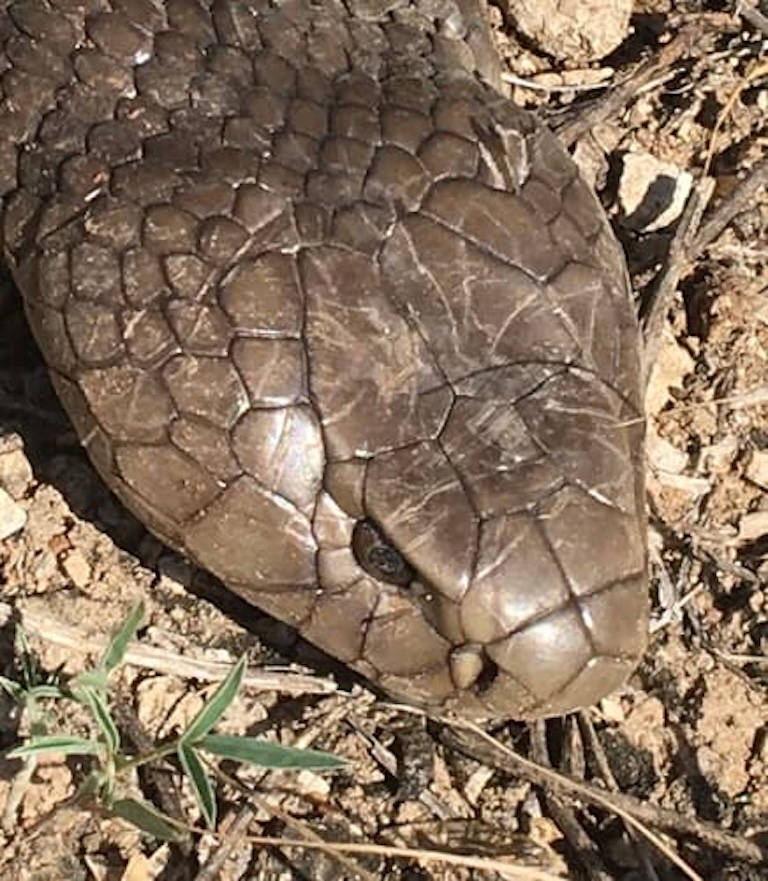Giant Spitting Cobra Profile
There are a lot of frightening animals that aren’t dangerous and a lot of dangerous animals that aren’t frightening, but for some reason, cobras just look the part. They have prehistoric, huge scale armour on their heads and angry-looking eyes, which if you pester them enough, are framed by the iconic flattened neck right before they strike at you.
They’re also really long snakes, which gives them a much longer striking distance than most, but spitting cobras take this one step further, and if they can’t reach you with their fangs, they can squirt neurotoxic venom into your eyes from over 2 meters away.

Giant Spitting Cobra Facts Overview
| Habitat: | Savanna, grassland |
| Location: | Eastern and Northeastern Africa |
| Lifespan: | Likely more than 20 years |
| Size: | Up to 2.7 m (8.9 ft) long |
| Weight: | Likely no more than 10kg (22lb) |
| Colour: | Dark, olive brown |
| Diet: | Rodents, lizards, frogs and toads |
| Predators: | None |
| Top Speed: | Unknown |
| No. of Species: | 1 |
| Conservation Status: | Least Concern (IUCN) |
Spitting cobras are named after their ability to eject venom at their enemies. They use this as a defensive strategy, and would much rather you get out of their face, but they do occasionally get pushed to bite, and with disastrous consequences for the victim.
This spitting defence likely evolved especially to keep humans away, as they don’t have a lot of other threats, and despite the animosity between the two species, the cobras seem to be doing fairly well.
Interesting Giant Spitting Cobra Facts
1. They’re the biggest spitters
Spitting cobras exist all over cobra territory. They’re all true cobras, that is, they’re all in the Naja genus, and they’re all large and capable of ejecting venom to varying degrees toward a very unfortunate recipient.
This is purely a defensive tactic and has also been seen in some viper species, but spitting cobras are the best at it. Of the roughly 17 species, around half are found in Asia. The other half are in Africa, and of the lot, Naja ashei is the longest.

2. They release a lot of venom
If you measured your car’s horsepower by how many dreamy winter markets it could careen through before grinding to a halt, people would rightly stop talking to you.
Likewise, the popular media habit of quantifying snake venom by the number of people it could kill is really a misrepresentation of the animal and perpetuates unnecessary fear.
Perhaps there’s some legitimacy in measuring it in terms of multiples of the lethal dose, but saying the giant spitting cobra has “enough venom to kill 15 people” implies that it’s just waiting for the opportunity.
Spitting cobra venom hasn’t evolved to kill fifteen people and neither has their temperament. Regardless, this snake species produces copious amounts of it, and this is an impressive adaptation to a hostile environment.
This torrent of toxins is great for venom harvesting for antivenoms, but not so great for victims of the snake.
For a snake with no constrictive ability, there’s a need to kill struggling prey quickly to prevent injury. But their venom is also used in defence, and this snake has developed a highly accurate, long-range attack. 1 2
3. They’re accurate
Spitting cobras are so-called because their defensive strategy is to fire high-pressure streams of venom from the fangs, right into the face of an overbearing gawker or hungry predator.
As a venom, the toxins sprayed from a spitting cobra’s fangs are not mortally dangerous unless it’s injected. Still, getting sprayed in the eyes is a great way to go entirely blind if they’re not treated seriously and with immediacy. The sensible approach to having cobra venom in your eyes is to wash them, a lot, with water.
Essentially, this is a disabling attack, allowing the snake to evacuate the area while the threat is entirely neutralised. It’s not typical for the animal to follow up with a bite, and it’s far more likely to take advantage of the chance to escape.
But what’s outstanding about this attack is the accuracy of it.
While there doesn’t appear to be any hard data on this spitting cobra species, in other studied species, accuracy has been determined to be around 90% at 1.5 meters.
They’re able to lead their targets, too, which means they can hit you even if you’re on the move. This highly sophisticated tracking system needs advanced neural processing equipment in the brain and suggests a very powerful sensory system. 3 4
4. This is built-in
Spitting venom into people’s eyes is something that takes humans a lifetime of practice to perfect. Not so for the spitting cobra.
This highly specialised adaptation is hard-wired into the DNA of the animal, meaning that they can get started straight out of the box. Baby cobras, emerging from their eggs, have been known to spit from the moment they’re out.
Even the aim is an evolved trait – venom is not going to work unless it gets into a membrane. Even something as dangerous as cobra venom can’t do any harm if it’s on the skin, or even to an extent, in the mouth.
But the thin and vascular membranes of the eye are penetrable to the venom, and it can have local effects here, so the attack can only work if it gets into the eyes of the threat. 5

5. It might be human-repellent
Humans have a long and complicated relationship with snakes. Ever since one of them got us thrown out of the sandbox environment with an apple during Alpha testing, we’ve spent our entire history threatening and being threatened in turn.
Snakes like cobras were probably a decent source of meat for prehistoric Africans, and certainly, to this day, they compete with humans for agricultural land.
Venom typically comes in handy for both killing things to eat and causing a lot of pain to things that want to eat you. Spitting cobras do both, and it’s becoming clear that the squirt of venom to the eyes is likely an effective deterrent against taller, upright threats.
Cobras and humans have likely despised one another forever, and certainly long enough that the evolution of spitting appears to coincide with the arrival of humans, and occurs convergently, meaning that whenever humans got up in their grill, some species of cobra learned how to blind them.
And despite this very painful defence against bipeds with sticks, they have not yet been wiped out by vengeful apes.
6. They’re common
This species is thought to have a stable population, partially on account of it living in sparsely-populated areas, and at low densities.
There don’t seem to be the same pressures on the species that you find in many animals, so while there aren’t all that many of them, they’re thought to be living in a stable equilibrium at their comfortable densities.
Remarkably, it seems that humans and cobras, at least in this species, have reached a truce.
Giant Spitting Cobra Fact-File Summary
Scientific Classification
| Kingdom: | Animalia |
| Phylum: | Chordata |
| Class: | Reptilia |
| Order: | Squamata |
| Family: | Elapidae |
| Genus: | Naja |
| Species: | ashei |
Fact Sources & References
- East African Reptiles (2023), “Ashes spitting cobra Venom Extraction.”, YouTube.
- Henry Carnill (2015), “Spitting cobra strike in slow motion HD”, YouTube.
- “Ashe’s Spitting Cobra”, iNaturalist..
- Charles Q. Choi (2010), “Secret to Spitting Cobra’s Deadly Accurate Aim Revealed”, Live Science.
- HILLARY MAYELL (2005), “Cobras Spit Venom at Eyes With Nearly Perfect Aim”, National Geographic.
